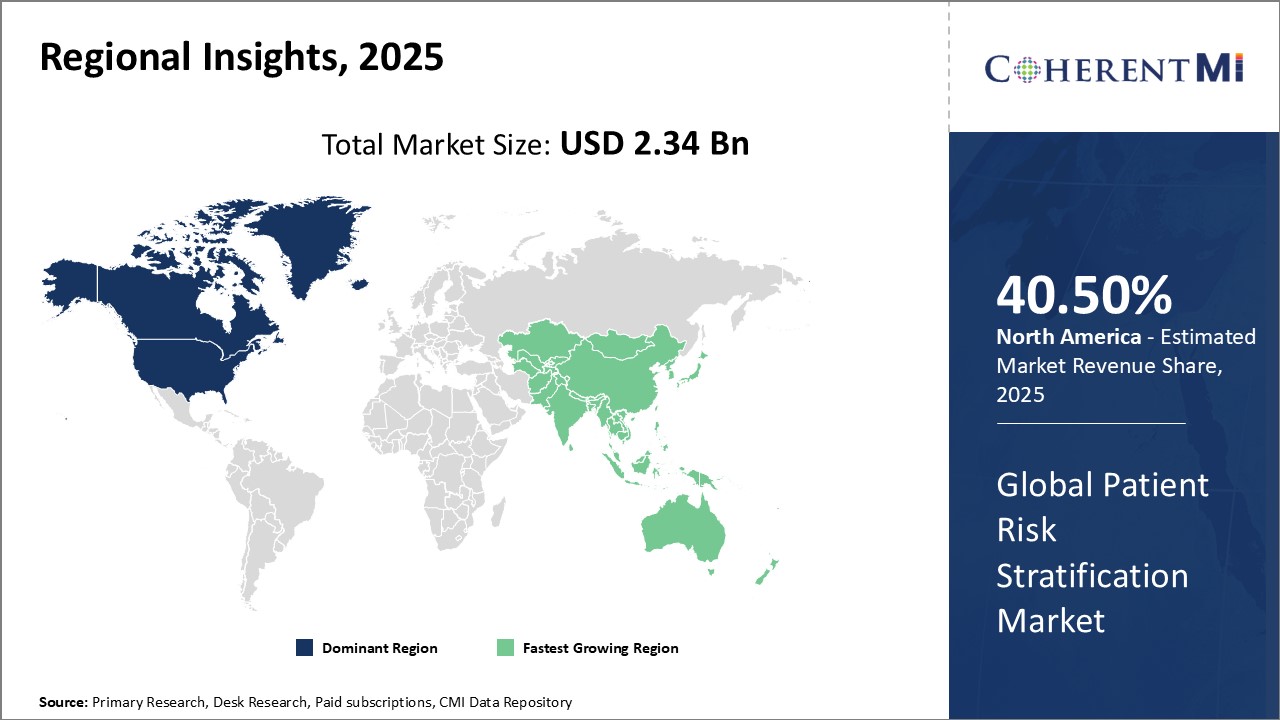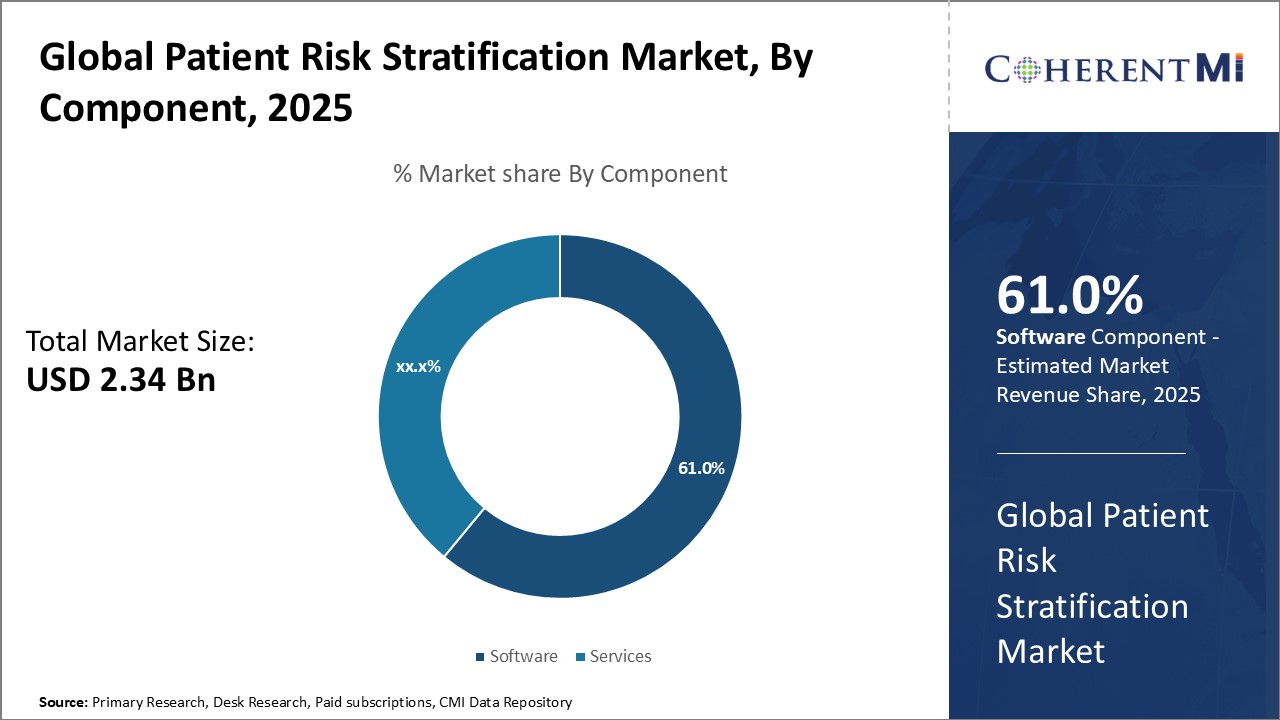Global Patient Risk Stratification Market Size - Analysis
Patient risk stratification is the process of identifying and grouping patients according to their risk of developing certain outcomes such as hospital readmission or complications from chronic diseases. It allows providers to target interventions toward patients who will benefit the most by patient risk satisfaction software and services. The key advantages of patient risk stratification include improved patient outcomes, reduced healthcare costs, and better population health management.
- Growing prevalence of chronic diseases: The rising prevalence of chronic diseases such as diabetes, cardiovascular diseases, chronic respiratory diseases, and cancer is a major factor driving the growth of the patient risk stratification market. Chronic diseases are long-lasting health conditions that require continuous health monitoring and care management. Risk stratification enables providers to identify patients at high risk of developing complications from chronic diseases and target preventive interventions accordingly. For instance, predictive analytics can identify diabetic patients at high risk of hospital readmission so they can be enrolled in care management programs to avoid adverse outcomes. The growing burden of chronic diseases is creating a need for advanced risk stratification to optimize disease management.
- Need to reduce healthcare costs: With rising healthcare costs, payers and providers are looking for innovative ways to improve outcomes while reducing costs. Patient risk stratification provides actionable insights to identify high-cost patients and align care delivery to their needs. For example, concurrent risk models can identify patients likely to incur high costs so care teams can prevent adverse events leading to unnecessary utilization and spend. Risk stratification is enabling value-based population health models aimed at reducing avoidable healthcare costs. According to estimates, the successful implementation of risk stratification can result in cost savings ranging from US$ 100 to US$ 1,000 per member per month for at-risk populations.
- Favorable government initiatives: Government policies and initiatives to promote preventive care, value-based reimbursement, and population health management are contributing to the adoption of patient risk stratification solutions. For instance, the CMS Medicare Shared Savings Program encourages accountable care organizations (ACOs) to use risk stratification to provide efficient and coordinated care. Additionally, risk adjustment programs require payers to stratify plan members accurately for capitated payments. Such programs are creating a conducive environment for the growth of the risk stratification market.
- Advancements in analytics, Artificial Intelligence (AI), and machine learning: Ongoing advancements in predictive analytics, artificial intelligence, machine learning, and big data techniques are enhancing the capabilities of modern risk stratification solutions. Natural language processing and unsupervised learning can extract insights from unstructured clinical notes and identify unknown patterns predictive of risk conditions. AI-based models can continuously self-learn and improve their predictive accuracy. Access to comprehensive real-world data is enabling more granular and precise risk stratification algorithms. Such technological enhancements are expected to significantly expand the adoption of risk stratification going forward.
Patient Risk Stratification Market Opportunities
- Leveraging real-world evidence (RWE) and big data: Real-world data from clinical settings and insurance claims provide extensive insights into patient health outcomes, treatment patterns, resource utilization, and costs. Leveraging RWE and big data in risk models can lead to more accurate predictions of clinical risks and trajectories. For instance, integrating socioeconomic and genomic data could account for social determinants of health inequities. Big data analytics can also power personalized risk assessment at an individual patient level. Overall, RWE and big data present significant opportunities to develop enhanced risk stratification frameworks.
- Adoption of patient risk satisfaction softwares in emerging economies: Emerging economies present untapped opportunities for growth owing to improving healthcare infrastructure, rising middle-class and health insurance, and increasing incidence of chronic diseases. Governments in developing countries are focused on enhancing access to affordable healthcare services. Risk stratification can assist providers in prioritizing resource allocation among high-risk low-income groups. Localizing risk models as per population health challenges will be key to adoption in emerging markets.
- Incorporation of social determinants of health: Social determinants of health (SDOH), such as food access, housing stability, transportation barriers, and financial toxicities, are being recognized as pivotal predictors of health risks. Incorporating SDOH data from community service providers could lead to better risk stratification, care coordination, and outcome improvements among disadvantaged populations. Addressing SDOH through risk-adjusted interventions is an impactful opportunity for payers and accountable care organizations.
- Patient-centered risk prediction models: Existing risk models predominantly rely on clinical and claims data inputs. Developing patient-centered models using patient-reported outcomes, wearable data, and other real-world data can enable more personalized risk assessment. For instance, remote patient monitoring and patient-reported data can provide real-time visibility into health changes between office visits. Such granular data can allow timely interventions based on dynamic risk predictions. Patient engagement in shared decision-making around risk information also promotes satisfaction and outcomes.
- Data privacy and security concerns: Concerns regarding data privacy and security associated with aggregating large volumes of patient data are hindering the market growth. There are apprehensions about the privacy of sensitive health data used for risk modeling by third parties. Stringent regulations governing cross-border patient data transfer also restrain market expansion. Healthcare organizations are often reluctant to embrace risk stratification due to cybersecurity risks and compliance obligations related to protected health information.
- High upfront costs: The high upfront costs of implementing risk stratification software, infrastructure, and resources is challenging, especially for smaller healthcare organizations with budget constraints. Substantial investments are required for EHR (Electronic Health Record) integrations, data warehouse setup, analytics platforms, and specialist hiring. The complex data infrastructure and long ROI (Return on investment) deters many providers. However, SaaS(Software as a service)-based models are emerging to provide more flexible and affordable options.
- Interoperability issues: Effective risk stratification relies on complete patient data aggregation across care settings. However, disparate vendor systems and fragmented data silos make assembling comprehensive records with full context challenging. Underlying interoperability issues between diverse EHRs, claims systems, registries, and other data sources hinder holistic risk analysis. Lack of standardized terminologies and specifications also hampers data integration.
Market Size in USD Bn
CAGR22.4%
| Study Period | 2025-2032 |
| Base Year of Estimation | 2024 |
| CAGR | 22.4% |
| Fastest Growing Market | Asia Pacific |
| Larget Market | North America |
| Market Concentration | High |
| Major Players | Cerner Corporation, Epic Systems Corporation, Optum, Inc., Allscripts Healthcare Solutions, Inc., IBM Corporation and Among Others |
please let us know !
Global Patient Risk Stratification Market Trends

- Cloud-based delivery models: Cloud-based risk stratification solutions are gaining increasing traction owing to benefits such as flexible scalability, rapid deployment, and reduced upfront costs. The cloud enables easy data sharing across diverse systems to create integrated patient views required for holistic risk assessment. Cloud analytics and machine learning resources can quickly run complex risk algorithms without extensive on-site computing infrastructure. Hybrid models blending cloud agility with on-premise data security are emerging. Overall, the cloud delivery model is a prominent trend in the risk stratification market.
- Health information exchange (HIE) integration: Integrating risk stratification solutions with regional health information exchanges and clinical data repositories enables comprehensive patient data access required for accurate models. HIEs serve as hubs for aggregated clinical data sharing between hospitals, physician offices, labs, pharmacies, payers, and other entities within a geographic area. Drawing upon the comprehensive HIE patient record for risk stratification provides more precise risk scoring. Healthcare organizations are thus increasingly looking to deploy risk stratification systems capable of embedded integration with HIEs.
- Ambulatory and home-based risk stratification: Risk models have conventionally relied on hospital claims data. However, there is a shift towards ambulatory and home-based risk assessment using clinical and remote digital data. Analyzing primary care and specialist visits can help prevent avoidable hospital utilization through early interventions. Similarly, remotely monitoring key vitals and health indicators between visits can enable early risk detection. Such community-focused risk assessment beyond hospital walls is an important trend.
- Natural language processing (NLP) for unstructured data: Unstructured clinical notes contain valuable patient information for risk models. NLP and speech recognition techniques are being used to unlock insights from physician narratives, discharge summaries, radiology reports and other narrative documents. NLP can automatically tag clinical concepts, extract risk factors, and encode into structured data. This allows incorporating unstructured clinical data in risk algorithms to make them more precise without extensive manual chart reviews.
Segmental Analysis of Global Patient Risk Stratification Market

Competitive overview of Global Patient Risk Stratification Market
Some of the major players operating in the patient risk stratification market are Cerner Corporation, Epic Systems Corporation, Optum, Inc., Allscripts Healthcare Solutions, Inc., IBM Corporation, Medecision, Inc., Health Catalyst, Inc., Conifer Health Solutions, LLC, Wellcentive, Inc., ZeOmega, Inc., Verscend Technologies, Inc., PreciseDx, CitiusTech Inc., Avero Diagnostics, Lightbeam Health Solutions, LexisNexis Risk Solutions, Milliman, Inc., NVision Health, RLDatix, and Verisk Analytics, Inc.
Global Patient Risk Stratification Market Leaders
- Cerner Corporation
- Epic Systems Corporation
- Optum, Inc.
- Allscripts Healthcare Solutions, Inc.
- IBM Corporation
Global Patient Risk Stratification Market - Competitive Rivalry

Global Patient Risk Stratification Market
(Dominated by major players)
(Highly competitive with lots of players.)
Recent Developments in Global Patient Risk Stratification Market
Key Strategic Initiatives
- In February 2023, Avero Diagnostics, a specialized cancer diagnostics company, launched the AMBLor Test which enables risk stratification in early-stage melanoma
- In January 2022, PreciseDx, a cancer risk stratification company, announced the raising of US$ 10.7 million in Series A preferred investment in 2021 to support the ongoing development and commercialization of its AI-powered risk classification platform
Collaborations
- In October 2022, GE Healthcare, a global healthcare company, and AMC Health, a healthcare technology company, announced a collaboration to meet the market need for a scalable Remote Patient Monitoring (RPM) solution that applies analytics and risk stratification to identify anticipated patient demand for future services, which could include admissions or readmissions
Global Patient Risk Stratification Market Segmentation
- By Component
-
- Software
- Services
- By Delivery Model
-
- On-premise
- Cloud-based
- By Type
-
- Predictive Risk Stratification Model
- Retrospective Risk Stratification Model
- Prospective Risk Stratification Model
- Concurrent Risk Stratification Model
- By Application
-
- Population Health Management
- Risk Adjustment
- Revenue Cycle Management
- Clinical Workflow
- By End User
-
- Healthcare Providers
- Healthcare Payers
- Other End Users
- By Region
-
- North America
- Latin America
- Europe
- Asia Pacific
- Middle East
- Africa

Would you like to explore the option of buying individual sections of this report?
Manisha Vibhute is a consultant with over 5 years of experience in market research and consulting. With a strong understanding of market dynamics, Manisha assists clients in developing effective market access strategies. She helps medical device companies navigate pricing, reimbursement, and regulatory pathways to ensure successful product launches.
Frequently Asked Questions :
How big is the Global Patient Risk Stratification Market?
The Global Patient Risk Stratification Market is estimated to be valued at USD 2.3 in 2025 and is expected to reach USD 9.6 Billion by 2032.
What are the major factors driving the patient risk stratification market growth?
Rising prevalence of chronic diseases, need to reduce healthcare costs, advancement in big data analytics and AI, favorable government policies, are the major factors driving the growth of the patient risk stratification market.
Which is the leading component segment in the patient risk stratification market?
The leading component segment in the patient risk stratification market is the software segment owing to the rising adoption of predictive analytics, EHR integration, and data aggregation solutions.
Which are the major players operating in the patient risk stratification market?
Some of the major players operating in the patient risk stratification market are Cerner Corporation, Epic Systems Corporation, Optum, Inc., Allscripts Healthcare Solutions, Inc., IBM Corporation, Medecision, Inc., Health Catalyst, Inc., Conifer Health Solutions, LLC, Wellcentive, Inc., ZeOmega, Inc., Verscend Technologies, Inc., PreciseDx, CitiusTech Inc., Avero Diagnostics, Lightbeam Health Solutions, LexisNexis Risk Solutions, Milliman, Inc., NVision Health, RLDatix, and Verisk Analytics, Inc.
Which region will lead the patient risk stratification market?
North America is expected to lead the patient risk stratification market in terms of market share throughout the forecast period.
What will be the CAGR of the patient risk stratification market?
The CAGR of the patient risk stratification market is estimated to be 22.4% from 2025 to 2032.